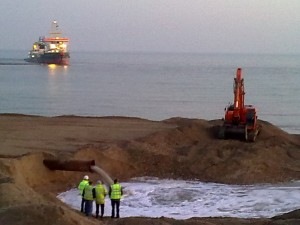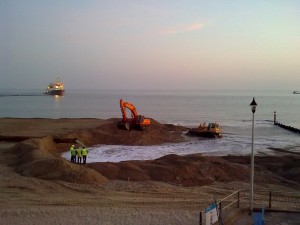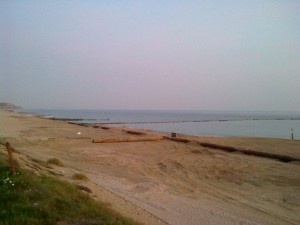BOURNEMOUTH BEACH REPLENISHMENT TOP UP – MARCH 2009
SOUTHBOURNE
GROYNES 50 TO 53
During the 20th century, the cliffs were protected from sea erosion by building concrete seawalls, promenades and groynes. This allowed houses to be built on the cliff tops, but it also stopped the natural supply of sand and gravel to the shore. The beach has been replenished by four previous “Beach Improvement Schemes”, and is now effectively an artificial beach.
Replenishment began in 1970, with 84,000 m3 of beach material, followed by 1,400,000 m3 in 1974/75, 1,000,000 m3 in 1988/90 and 600,000 m3 in 2006.
The 2006 replenishment was the first part of this current project, when a total of 1,100,00 m3 of beach material was dredged from Poole Harbour channels and approaches, and added to the beaches of Swanage, Poole and Southbourne. There was insufficient material to replenish all of Bournemouth’s beach, so in the winter of 2007, the scheme added 700,000 m3 to complete the beach.
This 700,000 cubic metres of sand was dredged from a Licensed Dredging Area off the Isle of Wight and was deposited on Bournemouth Beach, to protect it from erosion.
This current replenishment scheme allows for three annual top-ups to keep the beach volume high, this being the second top-up.
HOW WILL THE BEACH MATERIAL GET ONTO THE BEACH?
The beach material will be dredged off the Isle of Wight and brought by dredger close to the beach. Because of the shallow water, the dredger will pump the beach material ashore through a long floating pipe. To assist it being pumped, the beach material is mixed with a considerable amount of water. As the mixture exits the pipe, the water flows back to sea, leaving the sand and gravel behind. The beach is then levelled by bulldozers.
WHAT WILL THE BEACH LOOK LIKE?
Initially the beach material will look darker than that on the current beach, but will lighten to a normal colour with exposure to oxygen and daylight. In the first few weeks, small ledges may appear in the beach as wave action sorts the new material into a natural beach profile.
The replenishment will also result in a wider beach than we currently have.
WILL I BE ABLE TO USE THE BEACH WHILE WORK IS IN PROGRESS?
Yes, but in the interests of health and safety, it will be necessary to stop people using the short length of beach while material is being pumped ashore and moved by bulldozers. The closed section will be between Groynes 50 and 53, at Southbourne. There is a slight risk of quicksand during the replenishment work, so it is best not to go onto the new beach for a few days, until the water drains away completely. The promenade will remain open even when pumping is under way.
HOW LONG WILL IT TAKE?
It is proposed that the work begins in early March 2009, and will be completed within two weeks, dependant on calm weather conditions.
WHO IS PAYING?
The work is funded from 100% Grant Aid from The Environment Agency (formerly Defra the government (Department for Environment, Food and Rural Affairs). It is being carried out by Westminster Dredging Co Ltd on behalf of Bournemouth Borough Council.
WILL ANY FURTHER WORK BE NEEDED?
One more top up is planned for next year. The exact location and timing will be confirmed much closer to the time. The existing timber groynes 51 and 52 are life expired and will shortly be rebuilt, using the replenishment beach as a working platform.
THE BEACH MATERIAL
The dredging area off the Isle of Wight has been specifically selected as the material at this location is the most similar to the natural beach material at Bournemouth, and is within economical reach for the dredger. This will be a combination of approximately 80% sand and 20% shingle. Coarser material is needed to ensure the beach is not washed away, and it is possible that, from time to time, this naturally rises to the surface, particularly at more exposed areas in the east of the bay.
FURTHER INFORMATION CAN BE FOUND AT:
www.poolebay.net is a dedicated website including a daily diary. It will include any changes to the dates, as they occur.


